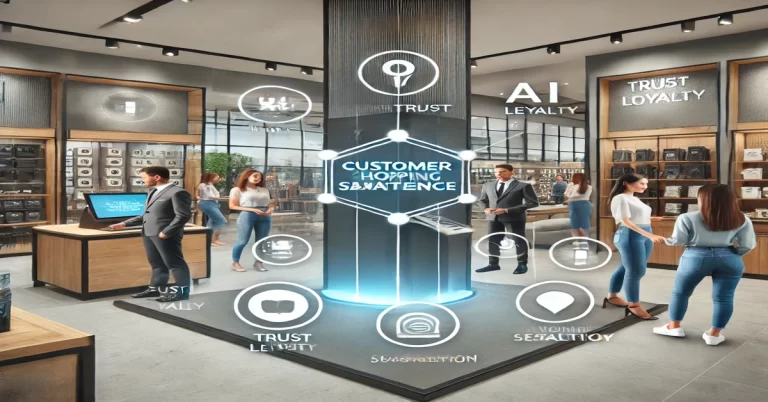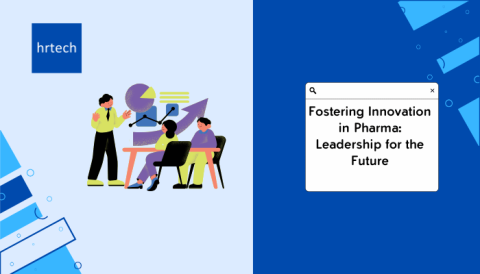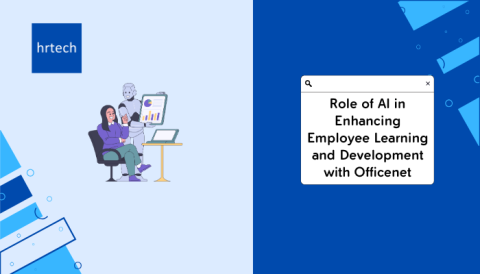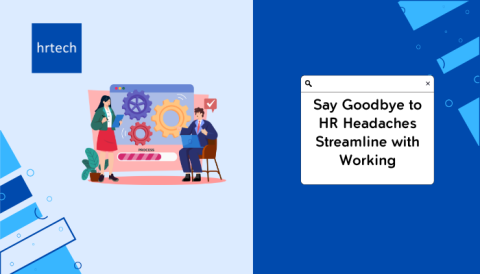Customer-centricity has become a crucial pillar for success in the retail sector. As consumer expectations continue to rise, the need for businesses to foster trust and loyalty has never been more evident. Retailers increasingly recognize that prioritizing the customer experience is not just a competitive advantage but a necessity for long-term success.
At the same time, keeping customers loyal is more complex than ever. With so many options available, customers are less loyal and more selective. This is where Brainayan comes in. Brainayan helps businesses strengthen their connection with customers by creating better shopping experiences. From understanding customer needs to offering solutions that build trust, Brainayan provides the tools and support retailers need to stand out and keep customers coming back.
By working with Brainayan, retailers can move beyond the basics of good service and deliver the experience that builds lasting relationships.
What is Customer Centricity?
Customer centricity in retail refers to a business approach that prioritizes customer needs, preferences, and satisfaction at every stage of the business process. In a customer-centric model, every decision, strategy, and action is made to deliver an exceptional experience that meets or exceeds customer expectations.
This approach places the customer at the heart of the business, ensuring that their desires and feedback shape how products, services, and interactions are delivered.
A customer-centric approach strengthens customer retention by understanding and addressing the unique preferences of your audience, creating experiences that encourage them to return. Repeat customers drive repeat purchases, leading to higher spending. Forbes reports that personalization in retail can boost customer spending by up to 500%.
Now that we understand the core of customer-centricity let’s explore how it plays a pivotal role in modern retail.
The Role of Customer Centricity in Modern Retail

In the competitive retail landscape, customer centricity in retail is not just a business philosophy but a strategic advantage.
- Enhanced Customer Experience: When businesses prioritize customer needs, they can create seamless, personalized experiences that encourage loyalty and long-term engagement. An effective HR solution is pivotal in creating such experiences, ensuring that the right talent is always in place to foster trust.
- Building Trust: A customer-centric approach fosters trust by consistently meeting customer expectations and addressing their concerns promptly. By aligning with the right communication tools, businesses can ensure that customer trust is built via effective dialogues.
- Competitive Differentiation: In a crowded market, offering an exceptional customer experience can differentiate your brand from competitors and position it as a leader in the industry.
- Increased Customer Loyalty: By focusing on customer satisfaction, companies can cultivate long-lasting relationships, leading to business and higher customer retention rates.
- Higher Profitability: Loyal customers are more likely to make repeated purchases and refer others, leading to sustained business growth and increased profitability.
Therefore, cultivating customer loyalty is not just an emotional connection; it’s a key driver of financial success for any business.
Key Metrics for Evaluating Customer Satisfaction and Loyalty
To measure the effectiveness of customer-centric strategies, retailers need to track specific metrics that gauge customer satisfaction and loyalty. These metrics provide valuable insights into how well a company meets its customers’ needs and help identify areas for improvement.
- Customer Satisfaction (CSAT): This metric measures customers’ satisfaction with a specific product, service, or interaction. Typically measured through post-purchase surveys, CSAT scores directly reflect how well a business is meeting customer expectations.
- Net Promoter Score (NPS): NPS evaluates customers’ likelihood of recommending a business to others. A higher NPS score indicates greater customer loyalty and satisfaction, as promoters are more likely to spread positive word-of-mouth.
- Customer Retention Rate (CRR): This metric tracks the percentage of customers who return to repeat purchases within a given period. High retention rates suggest strong customer loyalty and satisfaction, while low retention may signal issues with the customer experience.
According to Bain & Company, increasing customer retention rates by just 5% can increase profits by 25% to 95%.
- Customer Lifetime Value (CLV): CLV is the total revenue a business can expect from a customer throughout their relationship. A high CLV often indicates that customers find long-term value in the products or services offered, which directly results from customer-centric strategies.
- Customer Effort Score (CES): This metric measures the ease with which customers can resolve issues or meet their needs. A lower CES indicates that customers can interact with the business more efficiently, reducing friction and improving overall satisfaction.
Tracking these metrics enables retailers to understand customer loyalty and satisfaction at a granular level, allowing them to continuously refine their strategies and build stronger, more lasting customer relationships.
Retailers can leverage Brainayan to manage and optimize these strategies effectively.
Core Strategies for Customer-Centric Retail Operationsions
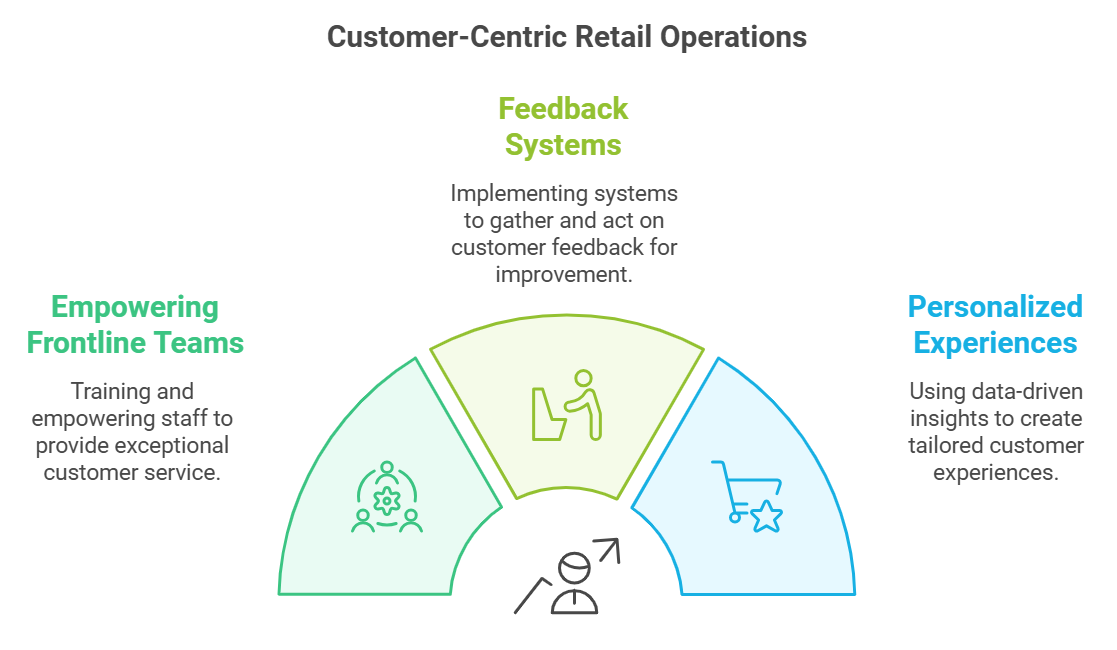
By focusing on key strategies, retail businesses can create seamless and personalized experiences that resonate with customers and keep them coming back. Implementation of advanced digital retail solutions enables businesses to automate personalization at scale while gathering valuable customer insights across multiple touchpoints. Here are three core strategies to adopt for building a customer-first retail operation:
Empowering Frontline Teams Through Training to Deliver Exceptional Service
Frontline employees are the direct touchpoint between your business and customers. As the face of your brand, they play a critical role in shaping customer experiences.
- Soft Skills Training: Frontline teams should have strong communication, empathy, and problem-solving abilities. Training programs should teach staff to actively listen to customers, empathize with their concerns, and respond with care and urgency.
- Product Knowledge: Empowering employees with in-depth knowledge about your products and services ensures that they can provide accurate and helpful information to customers, enhancing the overall shopping experience.
- Conflict Resolution: Equip staff with strategies for handling difficult situations or dissatisfied customers calmly and professionally. This helps build trust and ensures that issues are resolved promptly, leading to a more positive experience for the customer.
By continuously empowering your frontline teams with the skills and confidence to engage with customers, you improve service quality and enhance the overall customer experience.
Leveraging Feedback Systems to Continuously Improve the Customer Journey
Customer feedback is a powerful tool for driving improvement in retail operations. By systematically collecting and analyzing feedback from various touchpoints throughout the customer journey, businesses can identify pain points and areas for enhancement. Here’s how to effectively leverage feedback systems:
- Surveys and Polls: Regularly send out short surveys to customers after their online or in-store interactions. Ask targeted questions about product satisfaction, service quality, and overall experience.
- In-Store Feedback Tools: Use in-store kiosks, digital devices, or QR codes that allow customers to submit feedback during or after their shopping experience quickly.
- Social Media Listening: Monitor social media platforms for customer comments, complaints, and suggestions. Social media listening helps businesses stay connected with customer sentiments and proactively respond to issues.
- Customer Reviews and Ratings: Encourage customers to leave reviews on your website, third-party review platforms, or through feedback forms. Positive reviews can be leveraged as testimonials, while negative reviews provide valuable insights into areas that need attention.
By establishing multiple channels for feedback and consistently analyzing the data, retail businesses can make data-driven decisions that continuously improve customer satisfaction, streamline operations, and enhance the overall shopping experience.
Creating Personalized Customer Experiences Using Data-Driven Insights
Personalization has become a key differentiator in the retail industry, allowing businesses to tailor their offerings to meet each customer’s unique needs and preferences. For instance, premium brands like Swarovski use customer insights to personalize product recommendations and create exclusive experiences that reflect individual style and taste. By leveraging data-driven insights, retailers can create more meaningful and customized experiences at every touchpoint.
- Customer Segmentation: Use data to segment your customer base according to purchase behavior, location, demographics, and browsing habits. By understanding the distinct needs of different customer groups, you can offer tailored promotions, discounts, and product recommendations that resonate with each segment.
- Behavioral Data: Analyze customer behavior on your website, mobile app, or in-store interactions to understand preferences and shopping patterns. Use this data to create personalized product recommendations, targeted emails, or special offers.
- Loyalty Programs: Reward loyal customers by offering personalized incentives based on their purchase history or engagement. For instance, discounting a customer’s favorite product or providing early access to new releases can help deepen their connection to the brand.
By using customer data to personalize every aspect of the retail experience, businesses can enhance customer satisfaction and build stronger, more emotional connections with their audience, resulting in increased loyalty and lifetime value.
The Role of L&D in Driving Customer Centricity
Leadership and Development (L&D) programs are pivotal in driving customer-centricity within retail operations. These programs are not just about equipping employees with technical skills—they are about fostering a culture where customer satisfaction and loyalty are at the forefront of every interaction.
Programs to Enhance Communication and Problem-Solving Skills Among Retail Staff
Effective communication and problem-solving are fundamental to providing exceptional customer service. Retail staff, who interact directly with customers daily, need to be equipped with the skills to engage in clear, empathetic communication, handle difficult situations, and resolve customer issues promptly and professionally. L&D programs should include training modules that focus on:
- Active listening and empathy: Teaching staff to truly understand customer needs and concerns, fostering a connection that makes customers feel valued.
- Conflict resolution: Providing employees with tools and strategies to effectively manage and de-escalate customer complaints or issues.
- Product knowledge: Ensuring employees have a deep understanding of products and services, enabling them to confidently provide informed recommendations and address customer queries.
By investing in these core communication skills, retailers can ensure their staff are well-prepared to meet customers’ needs, turning every interaction into an opportunity to build trust and loyalty.
Leadership Development for Fostering a Customer-First Culture
Customer-centricity starts at the top, and strong leadership is essential for instilling a customer-first culture throughout an organization. L&D programs to develop retail leaders should focus on nurturing the skills necessary to create and sustain a customer-oriented mindset within teams. Key areas of leadership development include:
- Vision and strategy alignment: Teaching leaders to define and communicate a clear customer-first vision that aligns with the company’s broader business goals.
- Empowering frontline teams: Leaders should be trained to support and motivate their teams, providing them with the tools, resources, and authority to make customer-focused decisions.
- Creating accountability and recognition systems: Developing programs that recognize and reward customer-centric behavior, motivating employees to consistently prioritize customer satisfaction.
- Leading by example: Training leaders to demonstrate the importance of customer service in every decision they make, setting a tone that resonates throughout the organization.
By focusing on leadership development, L&D programs help create an environment where customer-centricity is ingrained into the culture, ensuring that every team member, from the CEO to frontline staff, understands the importance of putting customers first.
Looking Ahead: The Future of Customer-Centric Retail
The future of retail will continue to be shaped by customer expectations, which are rapidly evolving. As customers demand more seamless, personalized experiences, the retail industry must adapt, and customer centricity in retail will be at the core of this transformation.
Trends shaping customer expectations
- Omnichannel Experiences: Customers expect a consistent experience whether shopping online, in-store, or through mobile apps. Retailers must integrate these touchpoints to create a seamless journey.
- Technology Integration: Artificial Intelligence (AI) and automation are reshaping the retail landscape. From chatbots that handle inquiries to AI-driven product recommendations, technology will continue to enhance customer experience significantly.
How will training and development evolve to meet these expectations?
Training programs will prioritize data literacy as customer expectations shift toward more personalized, seamless experiences, enabling staff to leverage customer insights for tailored interactions.
Additionally, there will be an emphasis on upskilling employees using new technologies, such as AI tools, virtual assistants, and automated systems, to enhance customer service.
To address the growing demand for sustainability, training will also focus on educating teams about ethical practices and effectively communicating a brand’s sustainability efforts. Continuous, adaptive learning will prepare retail teams to meet these emerging demands.
Conclusion
As we’ve explored, customer centricity in retail is crucial for building trust and fostering loyalty, directly contributing to long-term business success. Retailers can ensure that they meet and exceed customer expectations by empowering frontline teams, leveraging feedback systems, and using data-driven insights to create personalized experiences.
Moreover, the role of Leadership and Development (L&D) programs in driving these customer-first initiatives cannot be overstated. Tailored training programs to enhance communication skills, problem-solving abilities, and leadership development are key to embedding a customer-centric culture.
To start shaping the future of customer-centric retail, explore L&D solutions with Brainayan. Invest in your people and see the difference it makes in driving customer loyalty and business success.
